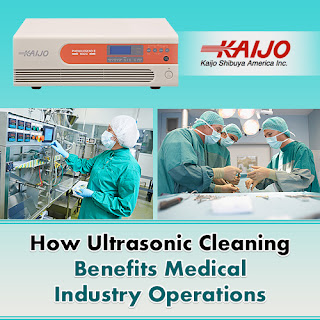The cleaning of reusable instruments, medical devices, and implants during medical industry operations is critical but is often difficult. Manual pre-cleaning, steam cleaning, and heat-sterilization are time-consuming and may damage delicate and temperature-sensitive instruments. Many of these instruments have complex shapes, which make them hard to access for manual cleaning.
Despite the difficulties, organic matter from previous patients and other medical facility contamination needs to be removed entirely to prevent infecting new patients.
The use of medical ultrasonic cleaners provides an ideal solution to many of these problems. This method uses an ultrasonic cleaner, which works by producing microscopic cavitation bubbles in the cleaning solution. The bubbles form and collapse in tune with the high-frequency sound waves passing through the liquid. When the bubbles collapse, they create a powerful scrubbing action against the parts' surfaces to be cleaned. Surface contaminants are dislodged and swept away.
In ultrasonic cleaning, the two critical factors for effective and successful cleaning of medical parts are the chosen frequency and power. Lower frequencies produce larger bubbles that provide a more intense cleaning of hard and robust parts. Higher frequencies generate comparatively smaller bubbles and gentler cleaning action of more fragile and delicate parts. Choosing the right frequency ensures that the parts are cleaned quickly and thoroughly without damaging the parts to be cleaned (especially the fragile and delicate medical parts and tools).
The power of the ultrasonic cleaning system must be enough to fill the tank with ultrasonic waves. These waves create bubbles throughout the liquid, even on interior surfaces, inside holes, or along cracks. While ultrasonic cleaning only dislodges physical surface contamination and does not kill pathogens, the systems can be used to sterilize parts by adding an appropriate amount of disinfectant to the ultrasonic bath.
The medical ultrasonic cleaner effectively cleans medical parts, tools, and implants provides improved cleaning performance, reduced cleaning times, and consistent results. These things lead to less time spent on cleaning tanks, better use of medical personnel who receive cleaner instruments, and improved patient outcomes.
Learn more about this topic by reading the complete article, “How Ultrasonic Cleaning Benefits Medical Industry Operations.” You may set up a free consultation to discuss your needs by contacting Kaijo at 408-675-5575 or email at info@kaijo-shibuya.com.


